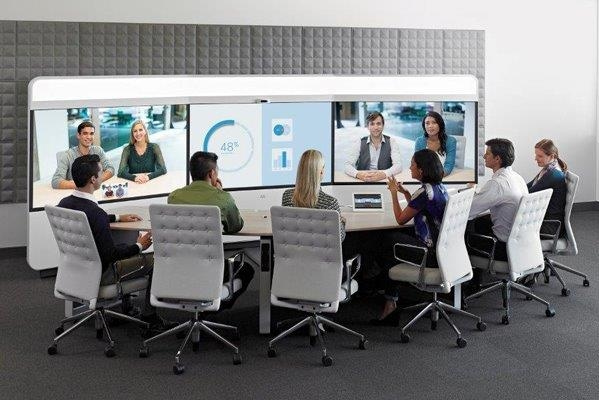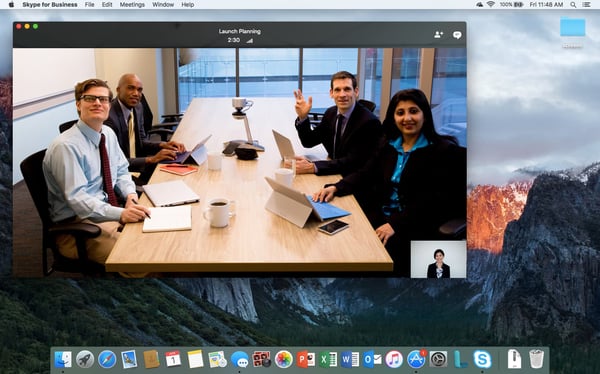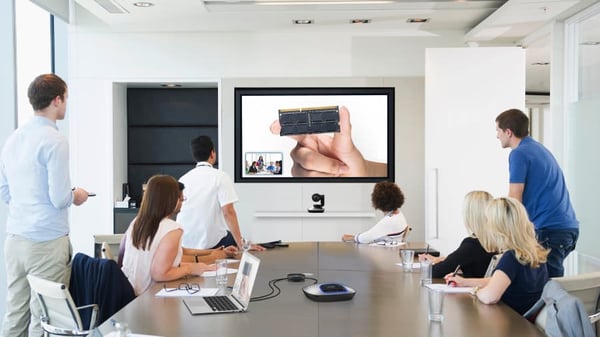If you've ever participated in a meeting, and you weren't physically in the office, you likely benefitted from video conferencing technology.
The technology connects with video conferencing apps to provide a high-quality video and audio experience for in-office and remote meeting attendees. When companies take advantage of video conferencing technology, they see benefits like clearer communication, increased efficiency, meeting attendee engagement, and the opportunity to collaborate with people who are distributed across multiple locations.
Let's demystify video conferencing technology and learn how you can use it to make your meetings even better.
What Is Video Conferencing Technology?
Video conferencing technology allows people who work in different locations, to communicate. The technology provides live audio and visual connections between two or more people who are distributed across different areas.
Since video conferencing technology includes audio and visual elements, there are a few AV components that are often involved:
- Displays: laptop, desktop monitor, television screen
- Microphones and cameras: built-in microphones and webcams, USB microphones and webcams
- Speakers: built-in computer speaker, external speaker, VoIP (voice over IP) conferencing phone
- Internet Connection: WiFi, ethernet
- Video Conferencing Software: video conferencing tools and apps
The best video conferencing technology is interoperable. But, what does this mean?
Interoperability means the video conferencing software can connect to and work with different software, applications, and devices.
Let's say a video conferencing camera has the ability to connect with a variety of video conferencing software (e.g., Zoom, GoToMeeting, Skype) -- this is an example of interoperable video conferencing technology.
When teams use video conferencing technology, they see a number of benefits. It allows distributed teams to connect and have meaningful conversations, with full audio and video. Plus, the technology can be used for a variety of meeting types. Depending on the video conferencing setup or situation, video conferencing technology can be used for:
- Team Meetings: Use video conferencing technology is used by hybrid teams to meet with all team members, regardless of their location.
- Webinars: Video conferencing technology provides high-quality audio and visuals for your webinars.
- Product Demos: Great video conferencing equipment can truly capture the full detail of your product.
- One-on-One Training and Support: With video conferencing technology, you can provide real-time support for major clients, and widen your talent pool by offering remote roles and training for remote employees.
- Job Interviews: Interviewers can see key visual cues through video conferencing technology -- this provides the same insights as an in-person interview.
How Does Video Conferencing Technology Work?
Video conferencing technology often consists of a few key components. There are endpoints, like a computer or a telepresence system, that's used by meeting participants. For example, one endpoint would be a remote worker's laptop while the other endpoint is a computer in a conference room.
These two endpoints are connected to a video conferencing server that allows them to communicate. Oftentimes, peripheral technology is used during video conferencing. This includes microphones, speakers, cameras, and echo cancellation equipment.
There's a variety of video conferencing technology and they all provide different features. Depending on the technology you use, there can be additional tools that enhance the video conferencing experience, like instant messaging, content sharing, and meeting recording.
Types of Video Conferencing Technology
If you're considering a video conferencing technology, there are different options you can choose from. Here are a few common video conferencing tools you can use.
1. Telepresence
Telepresence is an immersive video conferencing experience where all attendees, whether they're remote or in the office, feel as though they're having an in-person conversation. It often involves multiple screens or monitors so remote workers feel as though they're in the meeting room.
Telepresence Example:
This telepresence setup features three screens that face the meeting room table. This way, in-person and remote employees can interact face-to-face.

Source: Cisco
2. Desktop Video Conferencing Technology
With desktop video conferencing, all the conferencing hardware and software is built-in to the computer. This is one of the simplest video conferencing setups, as video conference attendees can participate with their desktop or laptop computer. These devices have the necessary software, cameras, speakers, and microphones built-in -- making it easier for remote workers to join the conference.
Desktop Video Conferencing Example:
Imagine you're working from home and using your MacBook to Zoom into a meeting. This is an example of desktop video conferencing.

Source: Microsoft
3. Room-Based Video Conferencing Technology
Room-based video conferencing means the technology is integrated into the meeting room itself. Screens or monitors, a video camera, a microphone, and a speaker are installed in the room, so meetings can be held between people in the conference room and those who are remote.
Room-Based Video Conferencing Example:
In this meeting room, the video camera and screens are on the wall, and the microphone and speaker are on the table.

Source: TechRadar
With a video conferencing setup, you'll be able to run successful meetings and connect with colleagues no matter their location.
Looking for more? Learn how to get rid of voice echoing in your video conference meeting next.
%20(1).png)
Better meetings start here
From huddle rooms to boardrooms and everything in between, we’ve got you covered with solutions that take teamwork to the next level.
Shop Solutions
